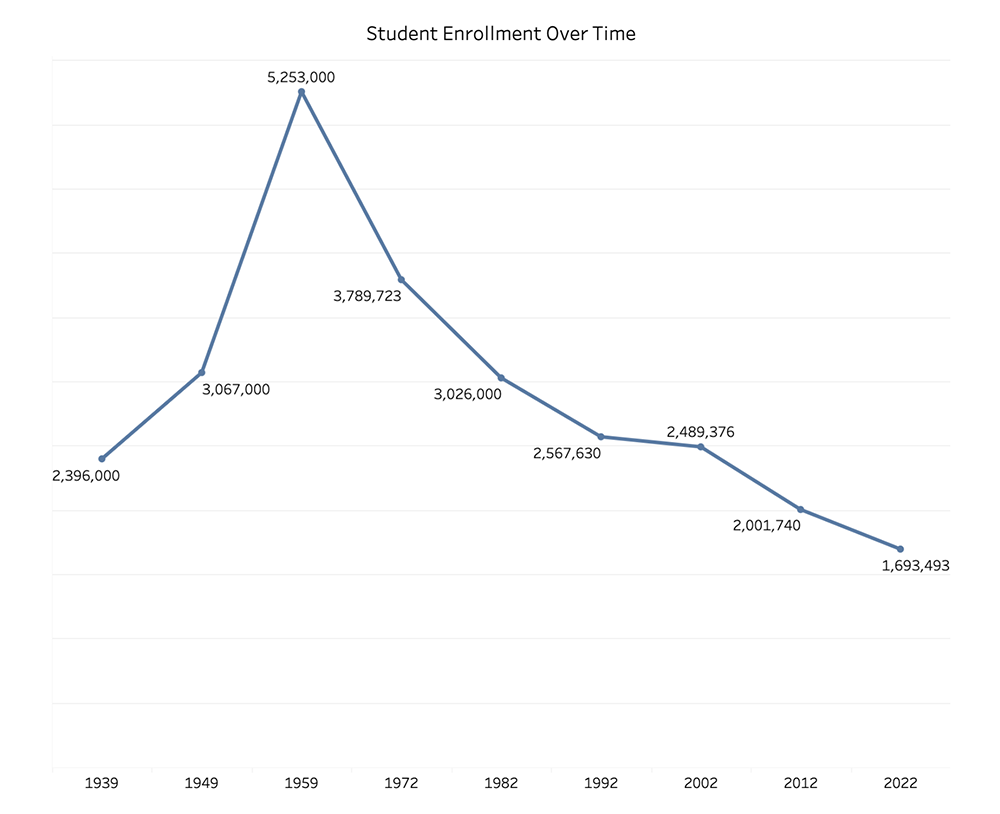Can We Be Frank About the Catholic School Crisis?
In the midst of a crisis, it’s natural to look for signs of hope—moments when the news isn’t so bad as it was before. But it’s perilous to ignore larger trends.
Coinciding with Catholic Schools Week, which starts January 29, the National Catholic Educational Association (NCEA) will release its annual report on Catholic school enrollment. Although the report makes no attempt to count Catholic homeschoolers and probably misses the growing number of independent schools providing faithful education, it is a vitally important benchmark for the Church.
Will we see an increase in enrollment?
Last year, the NCEA reported a 0.3 percent increase in Catholic school enrollment since the prior year, when it proclaimed a larger 3.7 percent increase. The numbers both years were expertly spun. The first annual increases in Catholic school enrollment in two decades! The largest increase in 50 years!
Yet it was presumptuous and even deceptive for pundits to suggest that these recent increases are evidence of a new trend in Catholic school enrollment.
We can certainly be hopeful about growing opportunities for school choice in many states. And regardless of parochial school numbers, we can be excited about faithful Catholic homeschooling and independent schools. And yet the media and many in the Church seem to willfully disregard other ominous trends in our culture and in our Church, including drastic declines in marriage and baptism. We need to be frank about these concerns with Catholic families.
The truth is, we are still in the post-pandemic period. In 2020-21, the number of students in Catholic schools dropped precipitously (6.4 percent) from the prior year, and 209 schools closed or merged nationwide. Until we see several more years of enrollment growth, we can’t be certain we are experiencing anything other than a recovery from losses during the pandemic. And if there are other drivers of the current growth, we have no idea if they will be long-term.
Consider the NCEA’s chart of long-term trends, with data points every decade instead of showing minor shifts each year. In general, the impact of the pandemic and post-pandemic increases are barely noticeable—from a broader perspective, the half-century decline of Catholic parochial schools is still a fact to be reckoned with.

(Retrieved on Jan. 26, 2024 from https://www.ncea.org/NCEA/NCEA/Who_We_Are/About_Catholic_Schools/Catholic_School_Data/Highlights.aspx?hkey=e0456a55-420d-475d-8480-c07f7f090431)
Moreover, despite the rosy news articles, the recent news for Catholic schools is not all good. The 0.3 percent enrollment blip was touted in headlines, but in fact the growth was entirely in pre-K enrollment, now 15 percent of all Catholic school children. If we disregard pre-K students, the enrollment in Catholic elementary schools actually declined in 2022-23.
Also, another 44 Catholic schools closed or merged last year, following 71 closures and mergers in 2021-22 and 209 in 2020-21. That’s disastrous! Yet pundits still suggested a great comeback of Catholic schools.
The problem is that data can be presented in multiple ways, and Catholics must avoid being distracted from the whole truth. Although the NCEA has every reason to present its data in the best light, Catholic parents and Church leaders have every reason to consider the whole picture—and from a broader perspective, the trends in Catholic schools are an enormous tragedy that the Church needs to resolve with eyes wide open.
The Cardinal Newman Society urges a renewal of faithful parochial schools, a full embrace of Catholic homeschooling and parent-led schools, and a Catholic exodus from public schools. But if Catholic leaders and educators instead ignore the true crisis, they abandon Catholic families to an increasingly hostile culture.
Here’s a perfect example of how data needs a proper perspective. Last year, the NCEA touted enrollment increases of more than 1 percent in nearly one-third of the nation’s Catholic dioceses. That sounds great, and it certainly bodes well for those dioceses. But if we look closely, most of those dioceses are in regions with the least numbers of Catholic schools, while the dioceses with many more Catholic schools did not fare so well.
The only region that saw a significant 1.7 percent increase last year was the Southeast — a region where Catholics have long been a minority. Now look at the Mideast and Great Lakes regions, where more than half of all U.S. Catholic schools were located 20 years ago. In those two decades, Catholic school enrollment has plummeted 34 percent in the Great Lakes and 51 percent in the Mideast!
That’s a crisis. But search last year’s news headlines from newspapers in these regions, and you’ll find that many (especially Catholic publications) reported good news for Catholic schools.
As for the Church, there’s an additional concern that deserves frank treatment: the rapidly declining numbers of Catholics in Catholic schools. The Church has always welcomed non-Catholic students—it’s a great blessing to many schools. But the portion of Catholics in Catholic schools is now 78 percent, a drop from 87 percent two decades ago and 97 percent in 1970.
In other words, while total enrollment at Catholic schools declined 55 percent in the 50 years before 2022-23, the decline among Catholic students is much worse: nearly two-thirds in the same time period. Recognizing that Catholic education is the Church’s most effective means of evangelization and Catholic formation, we call that an emergency.
And while many Catholics seem to be “partying like it’s 1999,” The Cardinal Newman Society is serving a growing movement of parents, educators, and Church leaders to build a new core of faithful Catholic education—at all stages of life, and in whatever form serves the needs of Catholic families.

